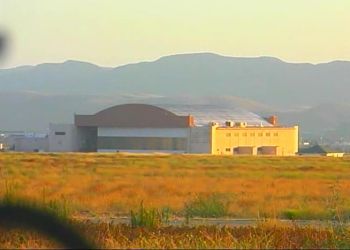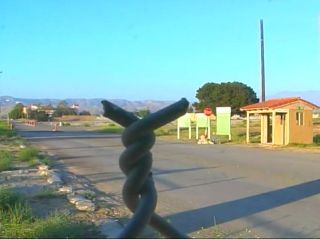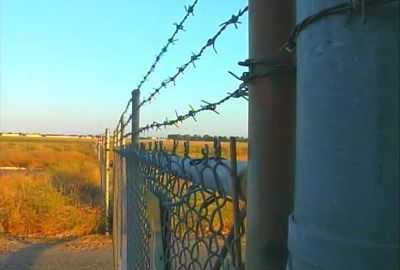
Publisher:
Bonnie King
CONTACT:
Newsroom@Salem-news.com
Advertising:
Adsales@Salem-news.com

~Truth~
~Justice~
~Peace~
TJP
Oct-22-2008 15:34

 TweetFollow @OregonNews
TweetFollow @OregonNews
El Toro's Wells Still Suspect
Robert J. O'Dowd for Salem-News.comThe quest for information into the history of serious toxic contamination at a now-closed Marine base in Southern California continues.
 Photos of the now-closed El Toro Marine Corps Air Station in Irvine, California by Tim King Salem-News.com |
(SOMERDALE, N.J.) - Marines at the El Toro air station in Orange County, California were contaminated by a toxic chemical and government agencies seem to have lost copies of the multi-million dollar contracts.
The Marine Corps Air Station at El Toro is closed now; the base wells abandoned and destroyed. For over 50 years, the Navy spent millions to purchase water for El Toro and the nearby Santa Ana Air Facility. But today the Navy can't explain why the water was purchased or the reasons the base wells were abandoned. With one exception, the dates the wells were abandoned are unknown. The integrity of the wells and the dates abandoned are important since the wells were located in the path of a major trichloroethylene plume.
Trichloroethylene or TCE, is a chemical degreaser marketed and sold by Dow Chemical. For decades the product was used on military bases like El Toro to clean military equipment. At El Toro the TCE was used to strip grease from Marine jet fighter aircraft.
History
MCAS El Toro was commissioned in March 1943. At that time, six base wells were constructed in the southwest quadrant of the base. The wells went deep into the principal aquifer under the base, avoiding the shallow aquifer’s poor water quality.
The Navy reported the purchase of municipal water from two municipal water districts and "no evidence" of the use of El Toro’s wells after the purchases. A major TCE plume went through the area of the base wells. An El Toro Public Works Department drawing showed 4 of the 6 base wells as part of the base's water distribution system after the initial purchase.
In 1951, the Navy awarded a contract to the Metropolitan Water District (MWD) for municipal water services for both El Toro and the Santa Ana Air Facility. In 1969, the Navy, as a result of property annexation, awarded a municipal water services contract to the Irvine Ranch Water District (IRWD).
The reasons for the purchase of municipal water are unknown. The Navy contends that well corrosion was not a factor despite the high levels of TDS ("salts") in the shallow aquifer. The only thing that is certain is that the Navy did not purchase municipal water without cause, especially when there was good quality water in the principal aquifer under the base.
In 1985 the Orange County Water District discovered a TCE plume spreading off of El Toro into Orange County's principal aquifer. Several years later, El Toro was placed on the EPA Superfund list. The source of the TCE plume was traced to the MWSG-37 area (EPA Site 24); the base wells were located there, too.

El Toro's wells were less than ten years old when the MWD contract was awarded by the Navy. Evidence suggests that not all of the base wells were abandoned in 1951. A 1954 El Toro Public Works Department drawing showed 4 of the 6 wells as part of the base's water distribution system. Except for one well abandoned in 1947, there's no record of the dates the other wells were abandoned.
All of El Toro's wells are now destroyed, the last one in 2007. NAVFAC Southwest directed the destruction of El Toro's wells. The work was done by consulting engineers and drillers under contract from 1998 to 2007. Well destruction permits were obtained from the Orange County Health Agency. NAVFAC described the methods of destruction for each well on the permit.
This was not an easy task for the consulting engineers and drillers since the well construction drawings were missing. Physical inspection of well casings revealed extensive corrosion, broken discharge pipes inside of casings, and at least one well failure.
The destruction work followed the California Department of Water Resource guidelines. For the first well destroyed, the consultant found 50 feet of the well screen in the contaminated shallow aquifer. In fact, the consulting engineer found TCE in excess of EPA’s MCL in the bottom of the well even though it was abandoned in 1947. After the first well destruction, NAVFAC never directed its consultants to look for another well screen.
There’s no regulatory requirement to locate well screens when destroying water wells. But, when you have evidence of a misplaced well screen in a contaminated aquifer, missing construction drawings and other wells in the same aquifer, there's no logical reason not to look for them.
The obvious risk is that well driller in 1942 may have placed other screens in the shallow aquifer. A much greater risk is exposure to TCE in well water. The TCE plume went through the area of the base wells so any other well screens in the shallow aquifer would have allowed TCE into the wells. We don’t know if this happened.
We do know that the shallow aquifer was unsuitable for drinking water because of high levels of TDS and nitrates. The only thing for sure now is that all the wells are buried in concrete and no one knows if the well driller in 1942 in a hurry to construct the wells just made one mistake or a series of them.
The high levels of TDS in the shallow aquifer put the base wells at some risk of corrosion. “Hard water” or water with elevated levels of TDS can corrode pipes, water heaters, and drinking wells. The Navy disputes any evidence of corrosion, despite consulting engineers' well destruction reports of extensive corrosion in the well casings, the steel pipe installed while drilling the wells to prevent collapse of the well bore hole and the entrance of contaminants, and to allow placement of a pump or pumping equipment.

TDS are primarily minerals/salts. The more minerals dissolved into the water the higher the total dissolved solids. For drinking water a limit of 500 mg/L is desirable. At El Toro, the levels of TDS in the shallow aquifer are greater than 1,000 mg/L. The levels are so high that millions of dollars were spent to build the Irvine Desalter Project, a treatment facility just outside the former base, to remove TDS flowing from the shallow aquifer’s brackish water and treat the TCE plume.
In 1951, the Metropolitan Water District (MWD) agreed to furnish “about one cubic foot per second of softened water” to serve both El Toro and the Air Facility. Converting this unit of measure into gallons equals about 450 gallons/minute for both installations.
While this is a lot of water, it is about half of the maximum daily output of El Toro's base wells alone. Based on the relatively low quantity of water supplied by MWD and the age of the wells (only nine years since their construction), the odds favor the need to increase the supply of "softened" water without abandoning the base wells.
The Navy found "no evidence of well casing failure or any information indicating the continued potable or non-potable use of MCAS El Toro wells subsequent to the connection to the MWD water supply main." Simply put, the Navy's position is that the wells were not used after June 1951. Yet, there's evidence that some of the wells were operating after 1951.
A 1954 El Toro Public Works drawing "Modifications to the MWD Water Supply Line Location Plan" lists 4 of the original 6 wells as part of water distribution system. For the remaining two wells, one is shown as a dry hole (#3) and the other as abandoned (#4).
Could elevated levels of TDS in the shallow aquifer caused serious well corrosion, shortened their useful life, and forced the decision to abandon the wells? Maybe. By 1951, the Navy is shopping to purchase municipal water. Something had to be wrong with the base wells for the Navy to purchase municipal water.
In 1969, the Navy's municipal water services contract with the IRWD estimated the daily demand at 1,700,000 gallons for El Toro. This was an increase in the water supply requirements above the maximum daily output from the base wells and may have allowed the base to abandon the wells.
The IRWD contract file may also indicate the reasons the base wells were abandoned and the need to continue the municipal water services for El Toro.
By 1969, there's evidence that El Toro's wells were not to be used even in the event of a disruption in water services. The 1969 IRWD contract required that the wells at the Marine Corps Air Facility be used to support El Toro in the event of disruption in water services resulting from a legal challenge to IRWD's annexation of property.
This IRWD contract remained in effect until the sale of El Toro in 2005. Navy regulations require the retention of contract files until 6 years and 3 months after final payment. Based on my calculations, these records should be available until sometime in 2011.
On August 10th, a Freedom of Information Act (FOIA) request was sent to the Navy asking for copies of the justification for the IRWD contract. An October 2nd response from the Navy stated that they were unable to locate supporting documents for the IRWD contract, including any documents describing the need to purchase municipal water service for El Toro.
An appeal to the Navy General Counsel asking for his intervention to locate the contract file was filed this week. Once the IRWD contract file is found, maybe we'll all know the answer to this puzzle.
Articles for October 21, 2008 | Articles for October 22, 2008 | Articles for October 23, 2008





Quick Links
DINING
Willamette UniversityGoudy Commons Cafe
Dine on the Queen
Willamette Queen Sternwheeler
MUST SEE SALEM
Oregon Capitol ToursCapitol History Gateway
Willamette River Ride
Willamette Queen Sternwheeler
Historic Home Tours:
Deepwood Museum
The Bush House
Gaiety Hollow Garden
AUCTIONS - APPRAISALS
Auction Masters & AppraisalsCONSTRUCTION SERVICES
Roofing and ContractingSheridan, Ore.
ONLINE SHOPPING
Special Occasion DressesAdvertise with Salem-News
Contact:AdSales@Salem-News.com
Terms of Service | Privacy Policy
All comments and messages are approved by people and self promotional links or unacceptable comments are denied.
[Return to Top]
©2025 Salem-News.com. All opinions expressed in this article are those of the author and do not necessarily reflect those of Salem-News.com.